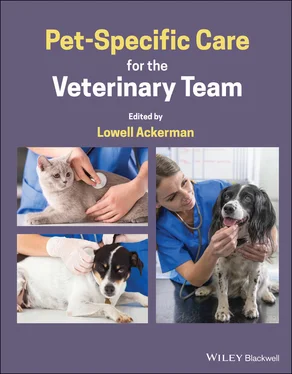Genotype: An individual's genetic constitution.
Heterozygote:An individual with two different alleles for a given gene.
Homozygote:An individual with two identical alleles for a given gene.
Locus:A fixed position on a chromosome for a gene or marker.
Penetrance:The likelihood of individuals in a population with a given genetic variant (genotype) fully displaying the clinical manifestations (phenotype) of that variant.
Phene:A trait or characteristic that is genetically determined.
Phenotype:Observable characteristics or traits that result from the interaction of genotype with the environment.
Recessive:Heritable characteristics, traits, or diseases that are expressed only when inherited from both parents.
 MAIN CONCEPTS
MAIN CONCEPTS
At its simplest, one would suspect that disease outcomes could be readily predicted if only the pattern of inheritance is known. However, things are rarely that simple when it comes to genetics. A few examples of genes, mutations, diseases, and modes of inheritance are in order to help explore the genetics of disease.
Fucosidosis is a rare but devastating lysosomal storage disease of English springer spaniels, transmitted as an autosomal recessive trait, meaning a dog would have to inherit an abnormal gene from each parent to be affected by the disease (see 11.3Heritable Health Conditions – By Disease). Although the abnormal gene itself does not kill the dog, it codes for an absent or nonfunctional enzyme (alpha‐L‐fucosidase) that can result in clinical problems. If the enzyme is not capable of breaking down its substrate, complex sugars collect within cells and eventually kill them. When the cells are severely compromised by this accumulated substrate, they die, and then the organs (primarily the brain) begin to be compromised, and eventually the situation will lead to the dog's demise. Carriers, who only inherited an abnormal gene from one parent, appear outwardly normal. Their levels of fucosidase enzymes, however, may be lower than normal, but not necessarily low enough to cause expression of the disease.
The same is true for many of the bleeding disorders, in which a defective gene does not produce a fully functioning protein or an enzyme important to clotting. Although carriers appear normal, their level of clotting factor may be lower than normal, just not low enough to cause spontaneous bleeding problems.
Whether a trait/phene is truly recessive depends on how hard one looks at the phenotype (see 3.2Modes of Inheritance). A dog with fucosidosis typically shows neurological signs early in life and has an abbreviated life span. The affected dog carries two copies of the abnormal gene. If a carrier, with one abnormal gene, has no outward problems as a pup but (theoretically) suffers from dementia and is euthanized at 7 years of age, can this truly be considered a completely recessive trait without influence? If the bitch that is the carrier of one hemophilia gene has no spontaneous bleeding episodes but has complications with bleeding during surgery or whelping, is she truly phenotypically “normal”? Young Labrador retrievers with late‐onset rod–cone degeneration may have measurably reduced retinal function.
In cutaneous asthenia, a disease of skin fragility, gene mutations that produce abnormal collagen are considered dominant because heterozygotes produce enough abnormal collagen to be evident, whereas procollagen‐processing mutations are considered recessive because heterozygotes (those with only one abnormal gene variant) usually have enough enzyme activity to convert procollagen to collagen. Thus, as more is learned about genetic conditions and testing improves, suppositions about dominant and recessive traits will have less impact on our genetic counseling skills.
3.3.3 Dominance and Disease
Now let's take a look at dominance. A trait that is completely dominant is easy to spot because the parent is affected and so are all or most offspring. In the case of a dog that is homozygous for a dominant trait, all pups should be affected. In the case of a dog that is heterozygous for a dominant trait, that dog and 50% of its offspring should be affected. What happens in many instances is that there is incomplete dominance or expression of a dominant trait with variable expressivity. This basically means the trait has dominant features with a spectrum of possibilities in the offspring. If penetrance of a dominant gene is complete, all progeny receiving the allele will express the trait. If penetrance is 50%, only half will express the trait. With variable expressivity, some genes may produce different degrees of expression of a phenotype, ranging from severe expression to absence of the trait.
For example, dermatomyositis in collies was originally believed to be an autosomal dominant trait, but it is now believed that, although the trait has dominant features, environmental components (likely viral infection) are required for full manifestation of the disorder. Other traits may be co‐dominant, each contributing to the phenotype. For dermatomyositis, the current DNA testing situation is that there appear to be at least three loci associated with an increased risk for developing the disease ( PAN2 gene on chromosome 10, MAP3K7CL gene on chromosome 31, DLA‐DRB1 on chromosome 12) and the three can be considered in aggregate when trying to determine relative risk. This can help identify pets that might be a low, moderate, or high risk for developing the condition. Other loci could eventually also prove to be associated with the condition.
An example of a dominant trait is merling of coat color. The normal, recessive genotype is the homozygote, mm. The heterozygous (Mm) animal has the characteristic merle coat coloring. The homozygous dominant (MM) animal is nearly all white, has blue eyes, and has a higher incidence of deafness. Although merle is a desirable feature in some dog breeds, the deafness and white coat color are completely undesirable. Breeders wishing to perpetuate merle in their lines will breed normal (mm) to merle (Mm) to achieve half typically colored offspring and half merle offspring. Fortunately, genetic testing for the merle trait is now available to facilitate that process, and avoid inadvertently creating homozygous dominant animals (MM) with health issues.
In most cases, recessive disorders are often attributable to enzyme deficiencies because heterozygotes with only 50% as much enzyme likely still have enough to perform needed functions. In contrast, dominant traits may be caused by defects in structural or substrate proteins, such that heterozygotes will be expected to be affected because these polypeptides are required in relatively large quantities. As more and more research accumulates, however, these suppositions seem to consist of more generalization than fact, and each trait is best considered individually.
A lot has been learned since Mendel began playing with peas, and new genetic tests that actually identify genotype deserve much of the credit (see 3.6Genetic Testing). Some of the old rules just do not apply, though. For example, mitochondrial myopathy in Clumber and Sussex spaniels is believed to be a sex‐linked but not an X‐linked trait. The trait is passed from the mitochondrial DNA of the maternal line to both sexes. Therefore, hemophilia A is X linked and is transmitted principally from mother to son, whereas mitochondrial myopathy is believed to be passed from mother to both sons and daughters.
Читать дальше

 MAIN CONCEPTS
MAIN CONCEPTS










